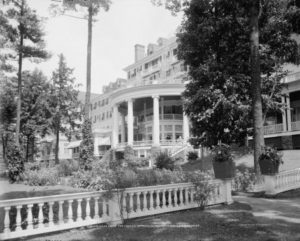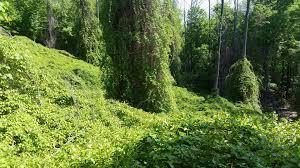Actinidia arguta is the scientific Latin name assigned to a plant commonly known as tara vine or hardy kiwi. This plant originated in Eastern Asia and the Himalayas. These plants are able to survive cold temperatures which makes them ideal for growing in the Northeast regions of America. In Asia, the wild fruits of hardy kiwi have been collected for centuries due to their taste and availability.

A photo of the Hotel Aspinwall in Lenox, Massachusetts. Suspected hardy kiwi can be seen growing along the trees in the above image. The hotel burned down in the 1930’s and is currently the site of Kennedy Park. Photo courtesy of Lost New England
In America, the genus Actinidia was extirpated from the continent nearly 80 million years ago during the shifting climate. It was reintroduced in 1877 when Colonel William S. Clark brought hardy kiwi seeds to America from Japan. He planted them at the Massachusetts Agricultural College, now known as the University of Massachusetts (Griffen, 2015).
As travel to Asia became more popular, more explorers were bringing seeds back to America. The plants became more widespread across New England and the entire Northeast of America where the hardy kiwi was able to thrive even during the cold winter seasons. The plants were favored for the vines that grew and could be manipulated to grow around fences, houses, and even walls. These plants were used to hide the “ugly sights” of properties and give a more natural feeling to the area. This was primarily done during the Gilded Age from between 1870 until the early 1900’s. These vines were seen as ornamental plants and the thought that they could be problematic did not cross the minds of early growers (Demchak, 2013).
As properties became more modernized, there was less area on properties to grow hardy kiwi just for aesthetic value. This is when more people realized the potential to use the plant as a crop. The hardy kiwi has a distinct taste that many say is more tasty than the kiwi bought commercially from stores. This changed the motivation to grow kiwi in the early to mid- 1900’s. Soon, hardy kiwi was

Current image of invasive hardy kiwi in Kennedy Park, Lenox, Massachusetts. It is believed that this invasive kiwi originated from the invasive kiwi growing at the Hotel Aspinwall.
being grown throughout Massachusetts and New England as well as into Pennsylvania and into Michigan and western states. Farmers viewed this as a potential crop that would be able to withstand the cold temperatures of the region. More and more people started planting hardy kiwi in their yards but again, over time, it fell out of favor. The property owners either sold the property, passed away, or just abandoned the land. Either way, the plants became abandoned as well. They were allowed to grow without management which is where the problem started. Without management, these plants are cold tolerant and able to spread, destroying native plant habitat and acting as an invasive plant species.
Literature Cited:
Demchak, K. (2013, March 22). Hardy Kiwifruit: Invasive Plant Or Throwback to the Gilded Age? (Tree Fruit Production). Retrieved March 26, 2017, from http://extension.psu.edu/plants/tree-fruit/news/2013/hardy-kiwifruit-invasive-plant-or-throwback-to-the-gilded-age
Griffen, J. (2015, September 12). Hardy Kiwi: Delicious, Decorative, Destructive. Retrieved March 26, 2017, from http://blog.uvm.edu/fntrlst/2015/09/12/hardy-kiwi-delicious-decorative-destructive/#_ftn2
